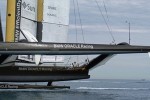 The physics here is fascinating. How is it possible that the America’s Cup challenger ”USA” can sail at 22 knots in only two knots of wind? Chuck Lantz of the Enquirer, explains how it is done.
The physics here is fascinating. How is it possible that the America’s Cup challenger ”USA” can sail at 22 knots in only two knots of wind? Chuck Lantz of the Enquirer, explains how it is done.
America’s Cup boatspeed – Making something out of nothing
Once the boat begins moving slowly in the light breeze, the sails are adjusted in slight increments, increasing the speed of the air flow across the sails. The faster the air flow, the more power is generated and transferred to the boat, moving the boat more quickly.
As the boat (and sails) move faster through the water, the airflow across the boat (called the “apparent wind”) also increases exponentially. At this point, the boat is essentially “making its own breeze”, and moving faster than the existing wind. This effect will increase until the drag of the water on the hull equals the wind power being generated, and the speed peaks.
Driving faster than the existing wind speed can be done in a single-hulled yacht if it’s designed well, and sailed well, but the ratio of wind speed to boat speed is much smaller. Getting a boat up to 20 knots of speed – about 23 miles per hour – in just 2 knots of actual wind, which is so slight that you would just barely feel it on your face, is absolutely astounding.
It happened on Sunday, February 7th, during the final practice session before the first race day of the event. While waiting for some “real” wind to arrive, and with owner Larry Ellison at the helm, “USA” began to move very slowly upwind into the 2 knot breeze (if you can call it that).
Before long, as the crew trimmed the hard mainsail and soft headsail on “USA”, the boat built enough speed to get the main hull and one of the two amas out of the water. At this point, the speed rose quickly to an honest 20 knots of boat speed, as recorded and sworn to by Richard Gladwell, editor and photographer at Sail-World.com. As far as the author knows, Richard rarely, if ever, fibs about such things.
